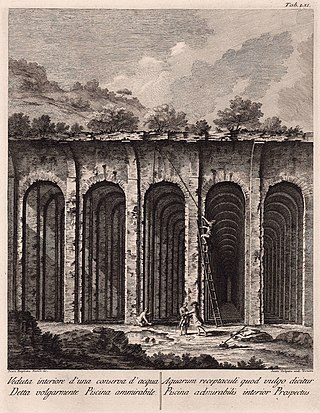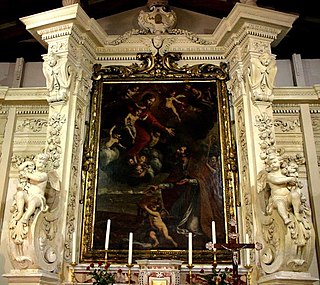Related Research Articles

Giovanni Battista Tiepolo, also known as GiambattistaTiepolo, was an Italian painter and printmaker from the Republic of Venice who painted in the Rococo style, considered an important member of the 18th-century Venetian school. He was prolific, and worked not only in Italy, but also in Germany and Spain.

Giovanni Battista Crespi, called Il Cerano, was an Italian painter, sculptor, and architect.

Giovanni Battista Castello was an Italian historical painter.

The Accademia di San Luca is an Italian academy of artists in Rome. The establishment of the Accademia de i Pittori e Scultori di Roma was approved by papal brief in 1577, and in 1593 Federico Zuccari became its first principe or director; the statutes were ratified in 1607. Other founders included Girolamo Muziano and Pietro Olivieri. The Academy was named for Luke the Evangelist, the patron saint of painters.

Giovanni Battista Piazzetta was an Italian Rococo painter of religious subjects and genre scenes.
Giovanni Battista was a common Italian given name in the 16th-18th centuries. It refers to "John the Baptist" in English, the French equivalent is "Jean-Baptiste". Common nicknames include Giambattista, Gianbattista, Giovambattista, or Giambo. In Genoese the nickname was Baciccio, and a common shortening was Giovan Battista, Giobatta or simply G.B.. The people listed below are Italian unless noted otherwise.

Pier Francesco Mazzucchelli was an Italian painter and draughtsman who was active in Milan. He is mainly known for his altarpieces, but his outstanding achievements are large decorative frescoes for the Sacro Monte di Varese and the Sacro Monte di Varallo.

Agostino Masucci was an Italian painter of the late-Baroque or Rococo period.

Giovanni Battista Paggi was an Italian painter, sculptor, and writer. His style spans the Late-Renaissance and early-Baroque.

Giovanni Battista Zelotti was an Italian painter of the late Renaissance, active in Venice and her mainland territories.
Events from the year 1699 in art.
Giovanni Battista Passeri was an Italian painter of the Baroque period. He was a pupil of the painter Domenichino, as the latter worked at Frascati. He painted genre and still life paintings.
Le Vite de’ Pittori, Scultori et Architetti. Dal Pontificato di Gregorio XII del 1572 in fino a’ tempi di Papa Urbano VIII nel 1642 is an art history book by Giovanni Baglione, first published in 1642. It represents an encyclopedic compendium of biographies of the artists active in Rome during late Mannerism and early Baroque. Baglione was a Late Mannerist and Early Baroque painter and art historian, best remembered for his writings and his acrimonious involvement with the artist Caravaggio, by whom he was nonetheless greatly influenced.

Giovanni Battista Natali, also known as Joan(nes) or Ioannes Baptista Natali, was an Italian painter and draughtsman of the late-Baroque period, active in his natal (?) city of Piacenza,[apparent contradiction] but also Savona, Lucca, and Naples, and finally Genoa in 1736.

San Marco is a church in Milan, northern Italy.

Giovanni Quagliata (1603–1673) was an Italian painter of the Baroque period. He is more properly known in Italy as Giovan Battista Quagliata, one of the leading artists of the Messinesi painters of the 17th century, as described by Francesco Susinno in his book "The Lives of the Messinesi Painters" published in 1724. Giovanni was born in Messina, Italy. He was a pupil of Pietro da Cortona and enjoyed the patronage and friendship of the Spanish Viceroy of Sicily, Don Juan José of Austria. Giovanni's brother, Andrea Quagliata, was also an historical painter, but of lesser significance. Giovanni's works – paintings, frescoes and large canvases – were famously displayed in the galleries and churches of Messina, but due to earthquakes from Mount Etna and wartime bombings, few have survived to the present day.

Pietro Campana (1727–1765) was an Italian engraver.
Pozzi is an Italian surname. Notable people with the surname include:
References
- Bryan, Michael (1889). Walter Armstrong; Robert Edmund Graves (eds.). Dictionary of Painters and Engravers, Biographical and Critical. Vol. II L-Z. London: George Bell and Sons. p. 317.
- ↑ Biografia universale antica e moderna ossia Storia per alfabeto, Compiled in France by a Society, Volume 46, Presso Giovanni Batista Missiaglia, Tipografia di G. Molinari, 1828, page 10.